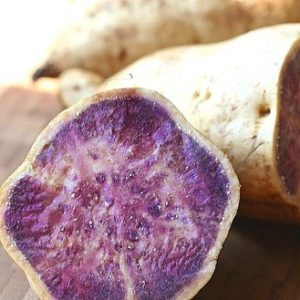
The Okinawan sweet potato is not related to the potato but is actually in the morning glory family. Native to the Americas, it was brought to Japan sometime between 1492 and 1605. The hardy plant grew well in Japan and quickly became popular in a variety of Japanese dishes. When it eventually made its way to the Hawaiian Islands, brought by the Polynesians, the crop flourished in the rich volcanic soil.
Sweet potatoes of all varieties are high in vitamin A, vitamin C and manganese. They are also a good source of copper, dietary fiber, vitamin B6, potassium and iron. Sweet potatoes are known to improve blood sugar regulation and some studies have discovered significant antibacterial and antifungal properties. The primary nutritional benefit, and the one for which Okinawan sweet potatoes are especially prized, is their high antioxidant levels. The antioxidant known as anthocyanin is the pigment which is responsible for the brilliant purple color of the flesh. It is the same pigment that gives blueberries, red grapes and red cabbage their color.
Blueberries are well known for their high antioxidant levels, however, the Okinawan sweet potato actually has 150 percent more antioxidants than blueberries. Antioxidants help to guard against cardiovascular disease and cancer.